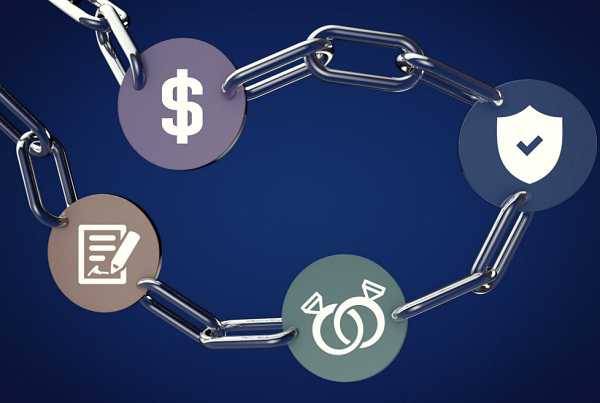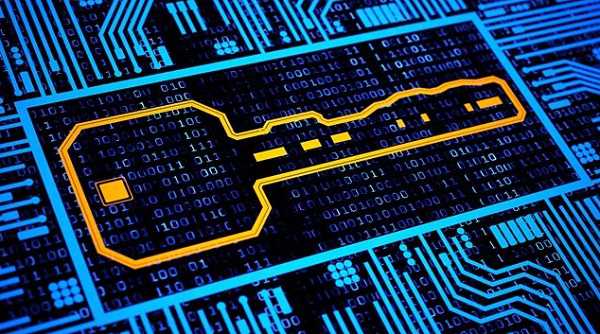A blockchain performs various functions which are supported by various features. These functions include but are not limited to transfer of value, managing assets and agreements. All of the blockchain tiers described in the previous section perform these functions with the help of features offered by blockchain, but with some exceptions. For example, smart contracts are not supported by all blockchain platforms, such as Bitcoin. Another example is that not all blockchain platforms produce cryptocurrency or tokens, such as Hyperledger Fabric, and Multichain.

Learn more: Blockchain 3.0
The features of a blockchain are described here:
• Distributed consensus: Distributed consensus is the primary underpinning of a blockchain. This mechanism allows a blockchain to present a single version of the truth, which is agreed upon by all parties without the requirement of a central authority.
• Transaction verification: Any transactions posted from the nodes on the blockchain are verified based on a predetermined set of rules. Only valid transactions are selected for inclusion in a block.
• Platform for smart contracts: A blockchain is a platform on which programs can run to execute business logic on behalf of the users. Not all blockchains have a mechanism to execute smart contracts, however, this is a very desirable feature, and it is available on newer blockchain platforms such as Ethereum and Multichain.
Smart Contracts
Blockchain technology provides a platformfor running smart contracts. These are automated, autonomous programs that reside on the blockchain network and encapsulate the business logic and code needed to execute a required function when certain conditions are met. For example, thinkaboutan insurance contract where a claim is paid to the traveler if the flight is canceled. In the real world, this process normally takes a significant amount of time to make the claim, verify it, and pay the insurance amount to the claimant (traveler). What if this whole process were automated with cryptographically-enforced trust, transparency, and execution so that as soon as the smart contract received a feed that the flight in question has been canceled, it automatically triggers the insurance payment to the claimant? If theflight is on time, the smart contract pays itself. This is indeed a revolutionary feature of blockchain, as it provides flexibility, speed, security, and automationfor real- world scenarios that can lead to a completely trustworthy system with significant cost reductions. Smart contracts can be programmed to perform any actions that blockchain users need and according to their specific business requirements.
See also: What is Blockchain Platform ?
• Transferring value between peers: Blockchain enables the transfer of value between its users via tokens. Tokens can be thought of as a carrier of value.
• Generation of cryptocurrency: This feature is optional depending on the type of blockchain in use. A blockchain can create cryptocurrency as an incentive to its miners who validate the transactions and spend resources to secure the blockchain. We will discuss cryptocurrencies in great detail in Chapter Introducing Bitcoin.
• Smart property: It is now possible to link a digital or physical asset to the blockchain in such a secure and precise manner that it cannot be claimed by anyone else. You are in full control of your asset, and it cannot be double-spent or double-owned. Compare this with a digital music file, for example, which can be copied many times without any controls, while it is true that many Digital Rights Management (DRM) schemes are being used currently along with copyright laws, but none of them is enforceable in such a way as blockchain based DRM can be. Blockchain can provide DRM functionality in such a way that it can be enforced fully. There are famously broken DRM schemes which looked great in theory but were hacked due to one limitation or another. One example is Oculus hack(http://www.wired.co.uk/article/ocu lus-rxft-drm-hacked).

Smart property
Another example is PS 3 hack, also copyrighted digital music, films and e- books are routinely shared on the internet without any limitations. We have copyright protection in place for many years, but digital piracy refutes all attempts to fully enforce the law on a blockchain, however, if you own an asset, no one else can claim it unless you decide to transfer it. This feature has far- reaching implications, especially in DRM and electronic cash systems where double-spend detection is a crucial requirement. The double-spend problem was first solved without the requirement of a trusted third party in Bitcoin.
• Provider of security: The blockchain is based on proven cryptographic technology that ensures the integrity and availability of data. Generally, confidentiality is not provided due to the requirements of transparency. This limitation is the leading barrier to its adoption by financial institutions and other industries that require privacy and confidentiality of transactions. As such, the privacy and confidentiality of transactions on the blockchain is being researched very actively, and advancements are already being made. It could be argued that, in many situations, confidentiality is not needed and transparency is preferred. For example, with Bitcoin, confidentiality is not an absolute requirement; however, it is desirable in some scenarios. A more recent example is Zcash, which provides a platform for conducting anonymous transactions. This scheme will be discussed in detail inChapter Alternative Coins. Other security services, such as nonrepudiation and authentication, are also provided by blockchain, as all actions are secured using private keys and digital signatures.

Provider of security
• Immutability: This is another critical feature of blockchain: once records are added to the blockchain, they are immutable. There is the remote possibility of rolling back changes, but this is to be avoided at all costs as doing so would consume an exorbitant amount of computing resources. For example, with Bitcoin if a malicious user wants to alter previous blocks, then it would require computing the PoW once again for all those blocks that have already been added to the blockchain. This difficulty makes the records on a blockchain essentially immutable.
• Uniqueness: This blockchain feature ensures that every transaction is unique and has not already been spent (doublespend problem). This feature is especially relevant with cryptocurrencies, where detection and avoidance of double spending are a vital requirement.
Learn more: What is Blockchain application ?








